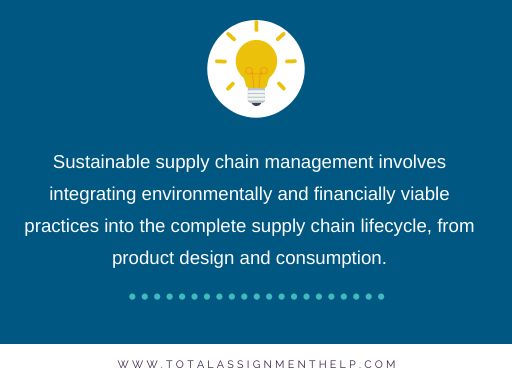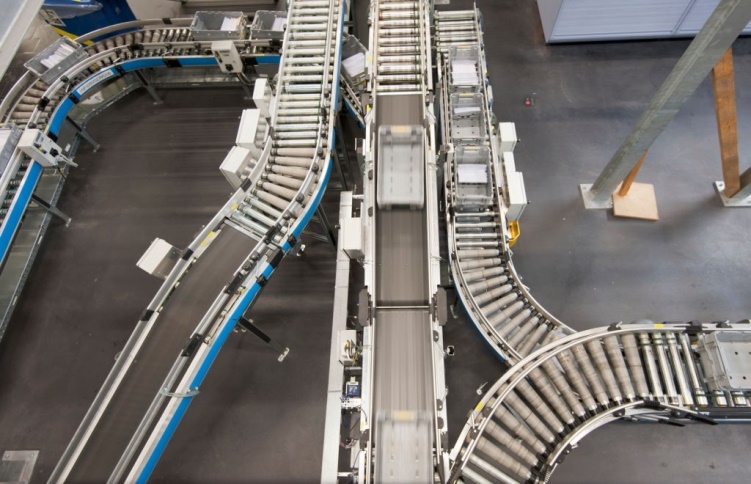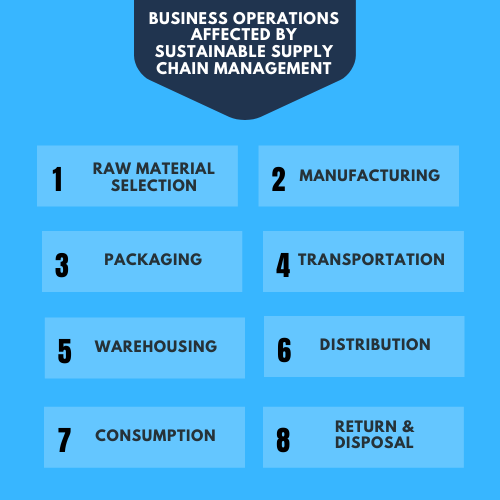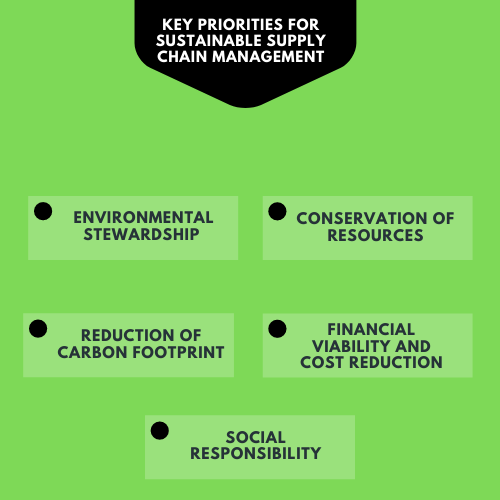Sustainable Supply Chain Management: Evolution And Future Directions
Question
Task: Objectively analyze how an organization should integrate Sustainable Supply Chain Management: Evolution and Future Directions
Answer
Introduction
Non-profit organizations constantly prompt organizations to act in a sustainable way (Wolf, 2014). Nestle (anti-deforestation), Nike (child labour), Apple (sweatshop labour) and Mattel (toxic materials) have put in efforts for Sustainable supply chain management: evolution and future directions (Wolf, 2014). Shareholder obligation keeps a company responsible for its activities and choices concerning the design, procurement, manufacturing and delivery of its goods (Wolf, 2014) (M.Zhang, Pawar, & Bhardwaj, 2017)). Sustainable growth, however, as asserted by Shrivastava, (1995)(cited in Liu, Bai, Liu, & Wei, 2017), has advantages outside direct encounters with shareholder's obligations, with the capacity to minimize the long-term influence on energy price volatility, emissions and resource management, and product uncertainties.

Sustainable growth is, therefore not only a question of being viewed as maintaining excellent social and environmental responsibility, but also a significant component of intelligent management. Supply chain management has been, as claimed by O'Marah, (2007), the cornerstone to fulfilling stakeholders standards for higher pay-out development with minimal uncertainty, policymakers and the media for environmental and economic accountability, and consumers for focusing on commitments made to clients (Liu, Bai, Liu, & Wei, 2017).
Sustainability
Sustainable supply chain management: evolution and future directions, is the pragmatic, consistent alignment and accomplishment of the social, environmental and economic priorities of an organization in the systematic management of key business and production actions to achieve the long-term economic success of the particular organization and its supply chain. Sustainable supply chain management: evolution and future directions allow management define tactics over long-term outlooks (for example 10 to 30 years or above) for the sustainability and success of an organization (Crum, Poist, Carter, & Easton, 2011). Liu, Bai, Liu, & Wei, (2017) indicate that concept of sustainable development and sustainable supply chain management: evolution and future directions programmes are a must for long-term organizational performance in general (Liu, Bai, Liu, & Wei, 2017)(Crum, Poist, Carter, & Easton, 2011). It can be defined as a comprehensive understanding of the sustainable supply chain management: evolution and future directions process and the innovations that are more than just distribution, expense and storage. The principle is focused on socially beneficial goods and services that require environmentally sustainable practises.

Multiple sustainable supply chain management: evolution and future directions efforts allow an organization to have a positive effect on the environment and community simultaneously and provide the organization with economic opportunities in the long run and competitive advantages (Liu, Bai, Liu, & Wei, 2017). Similar sustainable operations could possibly lead to results such as (Liu, Bai, Liu, & Wei, 2017):

- Lesser amount of packaging waste and the opportunities to develop recycling and retrieval resulting in cost reductions.
- Owing to enhanced protection and workplace conditions, lower expenses for occupational safety and health, training and employee retention.
- Lower operational expenses as a result of improved incentive and efficiency for workers and lower stress.
- Potentially impact forthcoming government legislation by constantly reviewing social and environmental challenges and thereby effectively generating hard to emulate competitive benefits.
- Decreased prices reduced lead times and enhanced quality standards in relation to the implementation of specifications (including such ISO 14000) which offer a basis for environmental sustainability processes.
- Enhanced customer loyalty, vendors, stakeholders and future staff.
In places where social or environmental policies might have the best financial effect ( (Liu, Bai, Liu, & Wei, 2017)Porter & Kramer, 2006), particularly logistics and distribution (e.g. processing, recycling, shipping implications), organizational concerns (e.g. pollution, power utilization, toxic waste, etc.), companies and corporations trying to incorporate Sustainable supply chain management: evolution and future directions should analyze their trade model. The goals of sustainable supply chain management: evolution and future directions programmes could also be organizational goals within the business strategy (e.g. partnerships with educational institutions to establish trained supply chain processes; requesting vendors to engage in programmes; purchasing from and expanding distributors operated by minority groups; joint preparation for reassembly, recycling and disposal with partners and suppliers) (Liu, Bai, Liu, & Wei, 2017).

There are several cases about how sustainable supply chain management: evolution and future directions can be implemented and incorporated by an organization. Starbuck Corporation has collaborated with producers to sustainably and soundly cultivate high-quality coffee, preserve the income of farmers at the same time and reduce buying costs by removing the intermediary (Liu, Bai, Liu, & Wei, 2017). In order to provide a stable supply of recyclable products, General Mills introduced a vertical integration closed-loop supply chain, massively minimizing packing materials costs for its goods (Liu, Bai, Liu, & Wei, 2017). Natura, a global company of Brazilian descent that operates in the skincare products, hygiene products and perfume market, is another example (Jabbour, Neto, Jr, Ribeiro, & Jabbour, 2015). By influencing suppliers to lower negative social and environmental consequences during product development, Natura promotes sustainability (Jabbour, Neto, Jr, Ribeiro, & Jabbour, 2015). -Utilizing outsourcing agreements, Natura implemented a distributor growth plan that lowers costs and effects on the environment by reducing transport distances of goods typically produced in Brazil; values essential principles of relationships essential to Natura, such as collaboration and co-development and values organizations with local expertise and strong environmental and societal norms. For instance, Natura Ekos goods practice innovations that mitigate ecological consequences in the supply chain; use renewable raw materials that could be directly attributed to origins including organic agriculture and ecological farming; and prioritize top-ups and labelling of renewable and recyclable materials (Jabbour, Neto, Jr, Ribeiro, & Jabbour, 2015).

Conclusion
Corporate sustainability strives to drive better standards at the same time and offer changes. Sustainable supply chain management: evolution and future directions include, among all things, decreased processing and also sustainable energy. Organizations operate together both internally and externally, and ultimately all workers need to understand it and endorse the necessary sustainability objectives. From an ethical perspective, it is vitally valuable for manufacturers to know what is required of them.
References
Crum, M., Poist, R., Carter, C., & Easton, P. (2011). Sustainable supply chain management: evolution and future directions. International journal of physical distribution & logistics management.
Hoffman, A. J., Bazerman, M. H., & Hoffman, A. J. (2006). Changing practice on sustainability: Understanding and overcoming the organizational and psychological barriers to action. Division of Research, Harvard Business School.
Jabbour, C., Neto, A., Jr, J. G., Ribeiro, M. d., & Jabbour, A. d. (2015). Eco-innovations and more sustainable supply chains for a low-carbon economy: A multiple case study of human critical success factors in Brazilian leading companies. Eco-innovations and more sustainable supply chains for a low-carbon economy: A multiple case study of human critiInternational Journal of Production Economics, 164, 245-257.
Kumar, R., & Chandrakar, R. (2012). Review of green supply chain management: operation and environmental impact at different stages of the supply chain. International Journal of Engineering and Advanced Technology, 1(3), 1-6.
Liu, W., Bai, E., Liu, L., & Wei, W. (2017). A framework of sustainable service supply chain management: A literature review and research agenda. Sustainability, 9(3), 421.
Lindgreen, A., Swaen, V., Maon, F., Andersen, M., & Skjoett-Larsen, T. (2009). Corporate social responsibility in global supply chains. Supply chain management: an international journal.
M.Zhang, Pawar, K., & Bhardwaj, S. (2017). Improving supply chain social responsibility through supplier development. Production Planning & Control, 28(6-8), 500-511.
O'Marah, K. (2007). The top 25 supply chains 2007. Supply Chain Management Review, 11(6).
Shrivastava, P. (1995). The position of corporations in achieving ecological sustainability. Academy of management review, 20(4), 936-960.
Wolf, J. (2014). The connection between sustainable supply chain management & stakeholder pressure along with corporate sustainability performance. Journal of business ethics, 119(3), 317-328.












